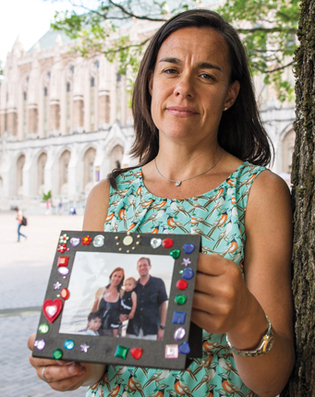 loading
loading
Where They Are NowAction in the wake of tragedyAn alumna works to prevent suicide.  Dean RutzJennifer Stuber ’02PhD—shown here with a photo of her family—learned after her husband's death that health care professionals in her state weren't required to know how to help suicidal patients. Now they are. View full imageJennifer Stuber ’02PhD will never forget the call. In 2010 her husband, Matt Adler, had taken a leave from his job as an attorney in order to deal with depression and anxiety. Stuber knew he was having trouble, but she did not realize how desperate he was—until their nanny called and said, “I think Matt has bought a gun.” They returned the gun, but he later bought another, and in February 2011 he took his own life. Stuber, an associate professor at the University of Washington whose doctorate is in public health, became an activist: she has helped pass three laws in Washington State aimed at preventing suicide. The first, named after her husband, requires that mental health care professionals receive suicide prevention training. The second gives schools greater ability to intervene when a student expresses suicidal thoughts. The third, passed in March, requires that all doctors and nurses also receive the training. Y: You’ve said that your husband wasn’t necessarily helped by the mental health community. S: I think they did some things that were counterproductive, and I think it’s not the fault of individual clinicians. Most health professionals really want to do right by people with mental health disorders and suicidal thoughts, but I think they just don’t know what to do or how to respond. I found out after Matt died that he had actually revealed to one mental health professional, as early as October 2010, that he was thinking of jumping off a bridge. This mental health professional should have taken action at that point and started a series of assessments and interventions that potentially could have saved my husband’s life. Y: Was that failure typical? S: That was. After he died, I was focused on trying to understand my husband’s mindset, but what I got back from suicide prevention experts was: “I’m really sorry for your loss. I’m not at all surprised. Health care professionals, including mental health professionals, are not required to know anything about how to deal with people like your husband.” I was quite shocked. To me the idea that mental health professionals didn’t have to know anything about this seemed like a public safety issue. Y: Doctors and nurses were not included in the first bill for suicide prevention training. Were you discouraged? S: A little. Most people who die by suicide never see a mental health professional, but they are very likely to see a primary care physician. Roughly 50 percent of all people who die by suicide see a primary care doctor within a month of their death. I don’t think people realize that it’s very difficult to pass legislation unless you’re trying to pass recognition for Martin Luther King Jr. But if you can work outside of session and bring together stakeholders who really have an interest in the issue beforehand, and get them to buy into the legislation, it actually isn’t so hard to pass. Legislators were deeply concerned about how this issue negatively concerns their communities. Y: Did you think it was likely the third bill would pass? S: I don’t think I actually had any sense it would pass until it passed. Even on the day of the bill signing with the governor, we weren’t sure it wouldn’t get vetoed. I should say that there are a lot of doctors and nurses who support the legislation and recognize that this is an opportunity for them to become better prepared on a subject that they don’t have adequate preparation in. But generally speaking, the health professions don’t like the requirement. They have a lot of requirements already put on them. So they don’t like additional requirements put on them by the state. I understand that they’re in a really challenging position, but when you’re treating depression, you’re prescribing people with what could be a weapon to kill themselves. Depression is a major risk factor for suicide, and we know that suicidal behaviors are very, very common and early intervention is possible. I think we haven’t had enough conversation about the fact that primary care has a very important role and responsibility to play. Y: What will you do from here? S: I’m working on building a suicide prevention nonprofit—Forefront—that picks up on the lessons that were learned from the legislative process. We’re providing training, and we’re doing policy work. For example, one of the things we know is that most people who die by suicide in this country are men who take their own lives with a firearm. And so, we’re interested in thinking about gun suicide and suicide prevention. We’re interested in talking a lot more about how to think about gun responsibility and helping people who are struggling—so they can be safe with respect to means like firearms, which are almost always deadly when they’re used in a suicide attempt. One of the things we know about people who die by suicide is that there’s a lot of ambivalence. It’s not the case that someone just wants to die by suicide and once they get that idea in their brain that’s what they’re going to do. People have a plan in their head. If you can stop them at that point, you can really save a life.
The comment period has expired.
|
|